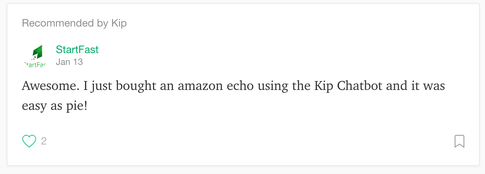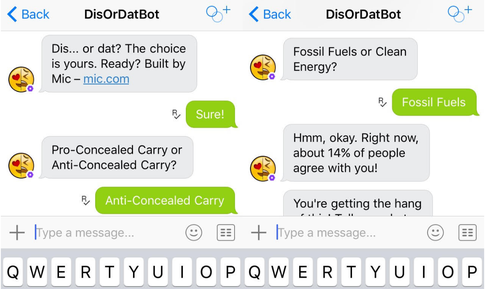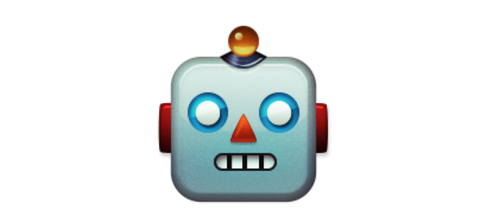Want smarter insights in your inbox? Sign up for our weekly newsletters to get only what matters to enterprise AI, data, and security leaders. Subscribe Now
Another bot (hot damn)
Called a police and a fireman
Another bot (hot damn)
Make your interface wanna retire man
You already know that bots are one of the hottest topics since mobile apps.
That’s already clear.
With major announcements from Google, Facebook, Microsoft, and Amazon, the bot craze has grown dramatically over just a few months.
But one question that is being discussed in boardrooms, amongst makers in Slack channels and in Facebook groups around the web is this:
AI Scaling Hits Its Limits
Power caps, rising token costs, and inference delays are reshaping enterprise AI. Join our exclusive salon to discover how top teams are:
- Turning energy into a strategic advantage
- Architecting efficient inference for real throughput gains
- Unlocking competitive ROI with sustainable AI systems
Secure your spot to stay ahead: https://bit.ly/4mwGngO
How will these things make money?
Well, that’s exactly what I’m going to dive into with this post. Over the last couple months, my co-workers and I have been up to something that leverages a bot and have had many conversations with bot makers on this exact topic.
So, here are seven business models that I expect bot makers to have the ability to leverage and redefine in the coming months.
Bots as a Services (BaaS)
B2B Bots that help people and teams be more productive, manage tasks or tackle communications challenges will replicate business models being used by existing B2B software.
I’m willing to bet that for B2B bots, the SaaS model is going to be the business model that floats to the top. For some bots, you will be able to access more features with an upgrade from one tier to the next. According to Forrester, SaaS and cloud-based business application services revenue is estimated to reach $32.8B in 2016 so it’s a no-brainer that this trend translates over into the B2B Bot space.
Most Slack apps available today are offering a free version of their product with a reference to future paid tiers like this pricing chart from Growbot:
This indicates an early comfort for SaaS.
SaaS is business model that b2b customers are familiar with and will require little education on how the transaction will work. Some of the bots will have complex pricing models that include seats and requests while others will have pricing options that are as simple as 3 different tiers.
Bots + sponsored & native content
Native content and advertising is a trend that has been soaring over the last few years thanks to the likes of BuzzFeed, VICE and more. Native or Sponsored content is a model in which brands pay to have their content distributed by media companies directly into their channels in a way that is often viewed as content created by the media outlet rather than a brand.
Here’s an example of native content from Durex:
Now imagine you’re using a Cooking Bot. While the bot will tell you that swapping Cumin for Coriander is okay in a certain recipe through its native function — it will also send you an article that talks about “5 Sriracha Infused Recipes That Will Leave Your Guests In Awe.”
Sponsored by Sriracha of course…
Native advertising has been found to consistently perform better than traditional banner ads. Brands will embrace this approach because it works for both the brand and publisher. You will see this transcend into the bots being created by publishers as well.
Bot leveraged affiliate marketing
Affiliate Marketing has been a monetization strategy for entrepreneurs and new businesses for years. In the early days, the model was quite simple, find a product that people were searching for frequently, create a website and landing page that would bring in traffic, run some ads and profit.
Forrester Research conducted a study that concluded that affiliate marketing spending in the USA would grow to $4.5 billion in 2016. For chat bot creators, you could develop a Fitness Bot that offers tips and tricks on how to stay healthy and use affiliate links to send people to fitness products that have affiliate links associated with them.
Shopping bot, Kip has already leveraged this monetization strategy. People can ask the bot for different things like “Chocolate” or “Coffee” and it will return a list of products:
And for every product bought by their users, the Kip bot team is able to ring the cash register and take a small percentage. Here’s one user explaining that they bought the Amazon Echo ($89.99) using the Kip Chatbot:
Bots for research
Wondering what millennials are thinking about the Presidential Election?
There are bots that you can pay to do the research for you. While I haven’t come across any bots that are doing this today, it would make a lot of sense for Q&A bots to offer this type of service.
Bots like DisOrDatBot are already asking people simple this or that questions as you can see in the experience above. Now, imagine you’re an event planner and are trying to determine which music act you should try to book for your city. Rather than using an expensive research firm or inaccurate focus group, you can run a research campaign with DisOrDatBot and ask users in your city whether they prefer Radiohead or Nickelback.
Slack Bots that don’t have a Q&A focus could also leverage this model. If you’ve built a bot that offers valuable content on a regular basis to a niche audience, organizations who want to connect or sell to that audience might have an interest in conducting research campaigns via chat.
Bots for lead generation
Lead generation businesses run wild online.
Create a landing page.
Acquire targeted leads.
Sell leads to producers.
Profit.
While I haven’t seen it yet, I expect we will see chatbots that act as lead generation businesses with an initial focus on content. The chatbots that deliver insights and information to users who are looking for advice about home ownership, insurance, weddings or finances and then pass along user information to various businesses who sell services and products that line up with the content they’re delivering.
For example, imagine you’re talking to the “Life Bot” and start engaging in a conversation about home buying. As the discussion continues, the bot gathers information like the amount of cash you have for a down payment, where you want to live, whether you’re employed and whether it’s your first home. After building this relationship, the bot asks you:
“Would you mind if I pass this along to someone to get in touch?”
You agree and the bot then it passes your information along to a Real Estate company in your area. The Real Estate company follows up with you the next day and the bot company gets paid for the lead.
Here’s the process:
(1) Company Creates Lead Generation Bot
(2) Bot Validates The Lead
(3) Lead Passed To Company
(4) Commision Paid By Company To Bot
Pure retail sales bots
Retail is one of the most straightforward experiences you will find amongst chat bots. It’s the idea of a store selling directly to the consumer (B2C). You can imagine stores like Wal-Mart, Harry’s, Target and Amazon creating bots where people can ask them if they sell something like “Tooth Paste” or “A shaver” and the bot responding back with those products. The user will make the purchase directly through a chat with the bot and it will act similar to a transaction from a typical website.
Ivan Suvorov, of Mr.Chatbot wrote a great piece on this:
Cost per conversation/task
People want advice and are willing to pay for good advice.
As bots become more sophisticated, I expect people to be willing to pay to have conversations with the bots that can help them with various challenges in life. For example, you could talk to the “Oprah Bot” if you needed life advice, the “Mechanic Bot” for information on your car or the “Marriage Bot” if you want anonymous marriage counseling.
Marriage counselors can charge anywhere from $75 to $200 or more per hour depending on where you live, the experience of the therapist, and the type of setting can all play a factor in how much counseling costs. Bots could help marriages at scale at a lower price point and be more accurate in their advice by leveraging the data they receive from their frequent interactions.
Conclusion
Tomasz Tunguz of Redpoint Ventures wrote a blog post titled The New UI for SaaS and asked a great question about the revenue model for bots:
How valuable is a user experience advancement to most software buyers?
That’s a great question but I think the advancement needs to go beyond user experience. It’s not just enough to make the interaction feel different. You need to make the experience better. You need to create an experience that saves time and has a meaningful impact on lives and business.
During an interview with Harry Stebbings of 20 Minute VC, Sam Lessin, Founder @ Fin and Partner @ Slow Ventures explains that business models for bots are yet to be determined and I couldn’t agree more.
It’s going to be an interesting next couple years and I’m excited to see what founders (myself included) come up with for the business model for bots. If you’re interested in learning more about bots and my thoughts on how they will redefine B2B, please subscribe to my newsletter.
A version of this post appeared on Medium.











